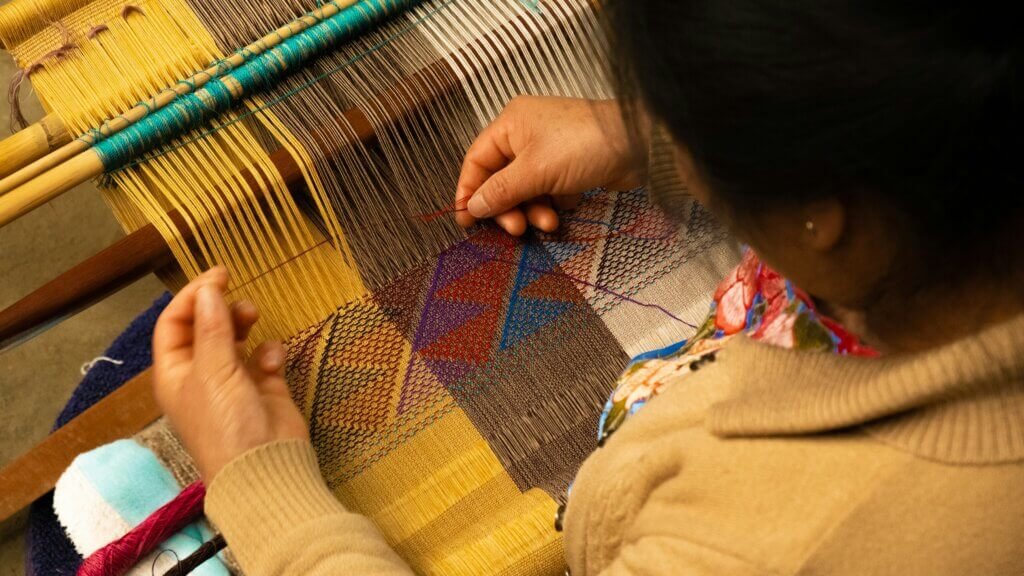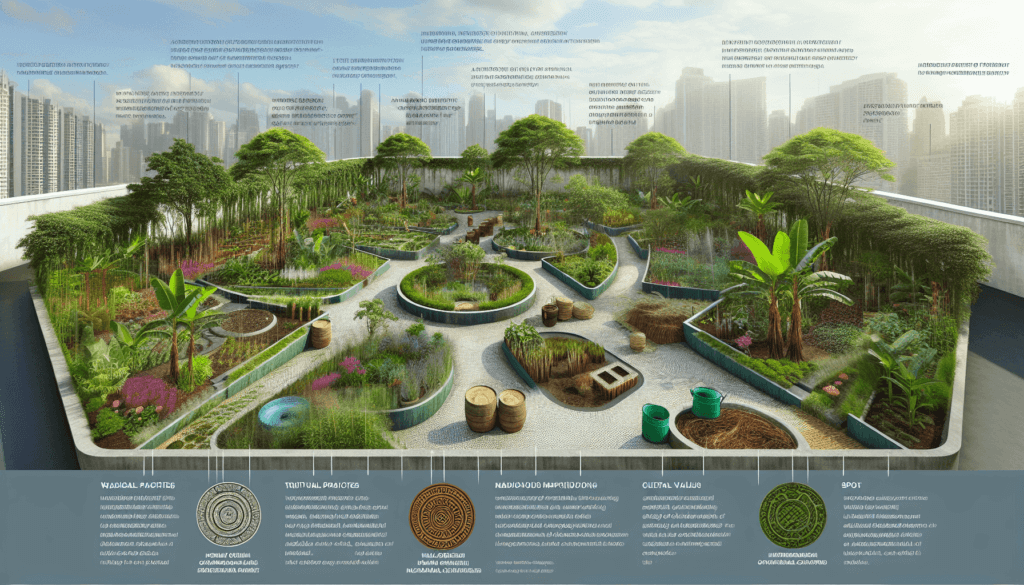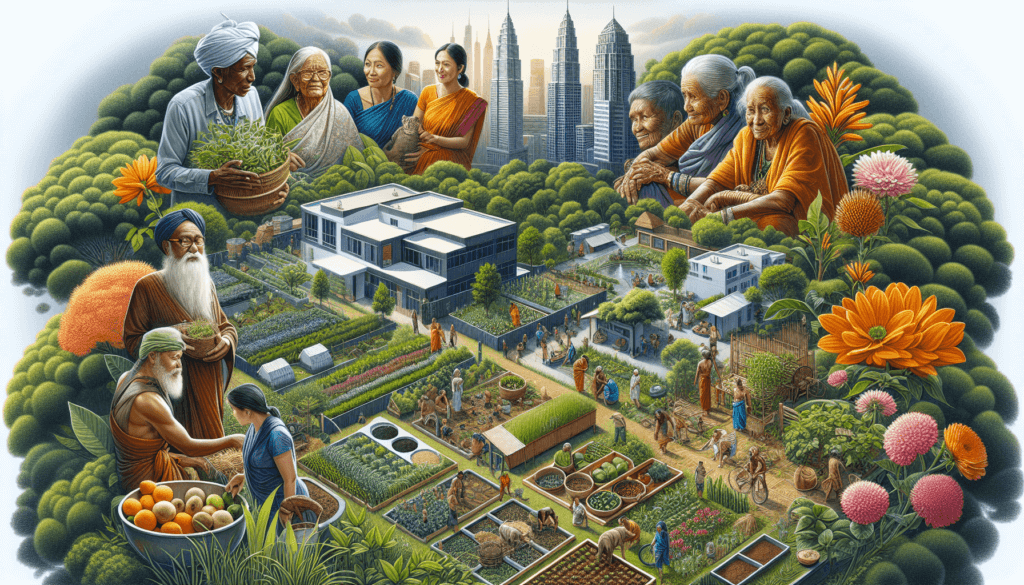Urban gardens have become increasingly popular in recent years as people embrace the benefits of growing their own food and reconnecting with nature. However, what many may not realize is the valuable role that indigenous knowledge plays in the design of these gardens. By drawing upon the wisdom and practices of indigenous cultures, urban gardeners can create spaces that not only produce healthy and sustainable crops but also honor the traditions and teachings of those who have long understood the intricate balance between humans and the earth. In this article, we will explore the fascinating ways in which indigenous knowledge enriches the world of urban gardening and offers a unique perspective on our relationship with the natural world.

Understanding Indigenous Knowledge
Indigenous Knowledge refers to the traditional knowledge, skills, practices, and beliefs that have been passed down through generations in Indigenous communities. It encompasses a deep understanding of the natural environment, including plants, animals, weather patterns, and ecosystems. Indigenous Knowledge is rooted in a spiritual connection with the land and a profound respect for nature.
Definition of Indigenous Knowledge
Indigenous Knowledge encompasses a wide range of knowledge systems that are unique to specific Indigenous cultures. It includes traditional farming and gardening techniques, herbal medicine, storytelling, and cultural ceremonies. Indigenous Knowledge is holistic, integrating environmental, social, and spiritual dimensions into a comprehensive worldview.
Difference between Indigenous Knowledge and Western knowledge
While Western knowledge tends to be based on scientific approaches and empirical evidence, Indigenous Knowledge is grounded in observation, experience, and deep cultural understanding. Western knowledge often focuses on specialization and compartmentalization, while Indigenous Knowledge takes a more holistic and interconnected perspective. Indigenous Knowledge values the interdependence of all living beings and emphasizes the importance of balance and harmony in ecosystems.
Importance of Indigenous Knowledge in preserving ecological balance
Indigenous Knowledge plays a crucial role in preserving ecological balance by providing sustainable and regenerative approaches to land stewardship. Indigenous communities have developed sophisticated farming and gardening techniques over centuries that promote biodiversity, conserve water, and maintain soil fertility. Furthermore, Indigenous Knowledge offers insights on the traditional uses of plants for food, medicine, and cultural practices, ensuring the preservation of valuable ecological resources.
Urban Garden Design
Urban Gardening refers to the practice of growing plants, vegetables, or herbs in urban environments, often in limited spaces such as balconies, rooftops, or community gardens. It is a response to the challenges of food insecurity, limited access to fresh produce, and the need for sustainable and resilient urban communities.
Definition of Urban Gardening
Urban Gardening has gained popularity as a means to reconnect with nature, promote food sovereignty, and foster a sense of community. It involves the cultivation of plants in urban areas, utilizing creative gardening techniques that maximize space and resources.
Benefits of Urban Gardening
Urban Gardening provides numerous benefits to individuals, communities, and the environment. By growing their own food, urban dwellers have access to fresh and nutritious produce, reducing their reliance on industrialized food systems. Urban Gardens also enhance green spaces, improve air quality, and mitigate the urban heat island effect. Additionally, community gardens foster social connections and create opportunities for education and skill-building.
Growing popularity of Urban Gardens
The popularity of Urban Gardens has surged in recent years, as more people recognize the value of sustainable and locally sourced food. Urban gardening initiatives have sprung up in cities worldwide, responding to the need for self-sufficiency, resilience, and community engagement. This growing movement reflects a desire to reconnect with the land, promote environmental consciousness, and address issues of social and food justice.
Incorporating Indigenous Knowledge in Urban Garden Design
To create truly sustainable and regenerative urban gardens, it is crucial to incorporate Indigenous Knowledge into garden design and practices. Recognizing the expertise of Indigenous communities, utilizing traditional farming and gardening techniques, emphasizing sustainable practices, preserving and promoting biodiversity, respecting cultural traditions and beliefs, and fostering community involvement and empowerment are key elements in this process.
Recognizing the expertise of Indigenous communities
Indigenous communities have unparalleled knowledge and expertise in land stewardship and sustainable agricultural practices. Their deep understanding of the local ecosystem, climate, and biodiversity can inform urban garden design and implementation. Recognizing and respecting their expertise ensures the integration of Indigenous Knowledge into urban garden projects, leading to more ecologically sound and culturally appropriate outcomes.
Utilizing traditional farming and gardening techniques
Indigenous cultures have developed innovative and sustainable farming and gardening techniques over generations. For example, intercropping, the practice of growing different crops together in the same space, maximizes soil fertility and reduces the risk of pest infestations. Crop rotation prevents soil depletion and enhances resilience against pests and diseases. Companion planting, where specific plants are grown together for mutual benefit, utilizes natural pest control and enhances crop productivity.
Emphasizing sustainable practices
Sustainability is at the core of Indigenous Knowledge. By incorporating sustainable practices such as rainwater harvesting, composting, mulching, and using organic fertilizers and pesticides, urban gardens can minimize their ecological footprint and contribute to a healthier environment. These practices not only promote soil health and conserve water but also reduce reliance on synthetic inputs and harmful chemicals, leading to safer and more sustainable food production.
Preserving and promoting biodiversity
Indigenous Knowledge recognizes the importance of preserving and promoting biodiversity. By incorporating native and heirloom varieties of plants, urban gardens can contribute to the preservation of plant genetic diversity. Avoiding monoculture and adopting polyculture practices, which involve growing multiple plant species together, support ecological balance and reduce the risk of pest outbreaks. Attracting pollinators, such as bees and butterflies, is crucial for plant reproduction and the maintenance of healthy ecosystems.
Respecting cultural traditions and beliefs
Incorporating Indigenous Knowledge in urban garden design requires deep respect for the cultural traditions and beliefs of Indigenous communities. This involves understanding the cultural significance of specific plants, incorporating sacred and medicinal plants, and honoring ceremonial practices that connect people with nature. By embracing cultural diversity and fostering cultural sensitivity, urban gardens become spaces of healing, spirituality, and cultural reclamation for Indigenous and non-Indigenous people alike.
Fostering community involvement and empowerment
Involving the community in urban garden design and decision-making is essential for creating sustainable and empowering spaces. Engaging Indigenous communities in the design process ensures their knowledge, experiences, and needs are taken into account. Encouraging knowledge sharing and intergenerational learning strengthens community bonds and allows for the transmission of Indigenous Knowledge to future generations. Urban gardens can also contribute to local food sovereignty, providing opportunities for economic self-sufficiency and fostering a sense of belonging and cultural identity within the community.
Traditional Indigenous Farming Techniques
Indigenous communities have developed a wealth of farming techniques over centuries to ensure food security and sustainable land use. These traditional farming techniques, rooted in Indigenous Knowledge, emphasize harmony with nature and the preservation of ecosystem health.
Intercropping
Intercropping is the practice of growing different crops together in the same space. By combining plant species with complementary growth habits and nutrient requirements, intercropping maximizes productivity and soil fertility. Indigenous farmers have long recognized the benefits of intercropping for pest control, weed suppression, and enhanced resilience against climate variability.
Crop rotation
Crop rotation involves alternating the type of crops grown in a specific area over a designated period. By rotating crops, Indigenous farmers prevent the depletion of nutrients in the soil and reduce the risk of disease and pest infestations. Crop rotation also fosters soil stability and fertility, contributing to long-term sustainable agriculture.
Companion planting
Companion planting refers to the intentional planting of different crops in close proximity to one another to enhance growth and repel pests. For example, planting marigolds alongside tomatoes can deter harmful insects, while growing beans alongside corn adds nitrogen to the soil. Indigenous knowledge of companion planting allows for natural pest control and increased productivity.
Seed saving and sharing
Seed saving and sharing is a practice deeply embedded in Indigenous farming traditions. By selecting, saving, and sharing seeds from the healthiest and most productive plants, Indigenous farmers preserve traditional varieties and ensure the resilience of their crops. This practice also promotes biodiversity and reduces reliance on commercial seeds, empowering communities to maintain control over their food systems.
Natural pest control
Indigenous farmers have developed various methods of natural pest control without relying on synthetic chemicals. For example, interplanting crops with natural insect repellents, using physical barriers to protect plants, or attracting beneficial insects like ladybugs and lacewings. By incorporating natural pest control methods, farmers can reduce the negative impacts of pesticides on human health and the environment.
Water conservation methods
Water conservation has always been a priority for Indigenous farmers, who understand the importance of preserving water resources in arid and semi-arid regions. Techniques such as terracing, mulching, and water conservation ponds help retain moisture in the soil, minimize evaporation, and ensure efficient water usage. These methods are integral to the sustainability and resilience of traditional Indigenous farming practices.

Promoting Biodiversity in Urban Gardens
Biodiversity is crucial for the health and resilience of urban ecosystems. By promoting biodiversity in urban gardens, we can create thriving habitats for plants, animals, and insects while enhancing the overall ecological balance of the city.
Planting native and heirloom varieties
Choosing to plant native and heirloom varieties in urban gardens is vital for promoting biodiversity. Native plants are adapted to local conditions and provide habitat and food sources for native wildlife. Heirloom varieties, on the other hand, are traditional plant varieties that have been passed down through generations. By cultivating these varieties, we preserve genetic diversity and support the unique cultural heritage associated with them.
Creating habitat for wildlife
Urban gardens can serve as vital havens for wildlife in the midst of concrete jungles. By incorporating features such as birdhouses, bee hotels, and butterfly gardens, we can provide essential habitat and food sources for a diverse range of species. This not only enhances the ecological value of urban spaces but also brings joy and beauty to people’s lives as they witness birds, bees, and butterflies thriving in their gardens.
Avoiding monoculture
Monoculture, the practice of growing a single crop over a large area, poses serious risks to biodiversity. By avoiding monoculture and diversifying the plant species in our gardens, we create a more resilient and balanced ecosystem. Cultivating a variety of plants with different growth habits, flowering times, and nutritional needs attracts a broader range of pollinators and beneficial insects while preventing the spread of pests and diseases.
Adopting polyculture practices
Polyculture is the practice of growing multiple plant species together in the same space. By adopting polyculture practices, urban gardens mimic the natural diversity found in ecosystems, promoting ecological balance. Different plant species interact with one another, creating mutually beneficial relationships that contribute to the overall health and productivity of the garden.
Attracting pollinators
Pollinators, such as bees, butterflies, and hummingbirds, play a crucial role in plant reproduction and the maintenance of healthy ecosystems. Urban gardens can attract and support pollinators by planting flowering native species, providing water sources, and avoiding the use of pesticides harmful to these essential creatures. Enhancing habitat and food sources for pollinators ensures the successful pollination of plants and the production of fruits and seeds.
Preserving and utilizing traditional seed knowledge
Preserving traditional seed knowledge is integral to maintaining biodiversity in urban gardens. Indigenous communities have long practiced seed saving, selecting the best seeds from their crops to plant again the following season. By preserving and utilizing traditional seed knowledge, we contribute to the conservation of traditional plant varieties and ensure the continued resilience and adaptability of our urban gardens.
Sustainable Practices in Urban Garden Design
Incorporating sustainable practices in urban garden design is crucial for mitigating environmental impact, conserving resources, and building resilient communities. By adopting these practices, urban gardens can minimize their ecological footprint and contribute to a healthier and more sustainable urban environment.
Rainwater harvesting
Rainwater harvesting is a sustainable practice that involves collecting rainwater for later use in the garden. By capturing and storing rainwater, urban gardens can reduce reliance on freshwater resources and mitigate the strain on municipal water supplies. Rainwater harvesting systems can range from simple rain barrels to more complex cisterns and storage tanks.
Composting
Composting is the process of converting organic waste into nutrient-rich compost that can be used to enrich the soil. By composting kitchen scraps, yard waste, and plant residues, urban gardeners can reduce waste sent to landfills and create a valuable resource for their gardens. Composting not only improves soil health but also reduces the need for synthetic fertilizers and promotes the growth of healthy and productive plants.
Mulching
Mulching involves covering the soil surface with a layer of organic material, such as wood chips, straw, or leaves. Mulch helps retain moisture in the soil, suppress weeds, regulate soil temperature, and improve soil structure. By mulching their gardens, urban gardeners can conserve water, reduce the need for irrigation, and promote healthy plant growth.
Organic fertilizers and pesticides
Using organic fertilizers and pesticides is a fundamental component of sustainable garden practices. By opting for natural alternatives instead of synthetic chemicals, urban gardeners minimize contamination of soil and water sources and promote the health of beneficial organisms, such as earthworms, bees, and butterflies. Organic fertilizers, such as compost and worm castings, provide a slow and consistent release of nutrients, ensuring the long-term fertility of the soil.
Using renewable resources
Utilizing renewable resources in urban garden design is essential for reducing reliance on non-renewable resources, such as fossil fuels and unsustainable materials. For example, using renewable energy sources, such as solar panels or wind turbines, to power irrigation systems or garden lighting, reduces greenhouse gas emissions. Additionally, using locally sourced and sustainable materials for garden structures and pathways minimizes the environmental impact associated with transportation and manufacturing.
Reducing waste
Minimizing waste is a critical aspect of sustainable garden design. By practicing mindful consumption, recycling, and reducing packaging waste, urban gardeners contribute to a circular economy. Composting organic waste, reusing materials, and embracing the principles of reduce, reuse, and recycle ensure that urban gardens are environmentally responsible and generate minimal waste.

Respecting Cultural Traditions and Beliefs
Respecting cultural traditions and beliefs is essential when incorporating Indigenous Knowledge into urban garden design. Indigenous cultures have a deep spiritual and cultural connection to the land, and their traditional practices reflect this relationship.
Understanding the cultural significance of plants
Each plant has its unique cultural significance within Indigenous communities. Understanding and respecting the cultural significance of specific plants ensures that they are incorporated in a culturally appropriate manner. For example, certain plants might be considered sacred or used in traditional ceremonies. By acknowledging and honoring these cultural beliefs and practices, urban gardens become spaces of cultural continuity and respect.
Incorporating sacred and medicinal plants
Incorporating sacred and medicinal plants in urban gardens acknowledges the importance of these plants in Indigenous cultures. These plants hold deep spiritual and healing significance and contribute to the cultural identity and well-being of Indigenous communities. By cultivating sacred and medicinal plants, urban gardens become living repositories of Indigenous knowledge and facilitate cultural exchange and learning.
Honoring ceremonial practices
Ceremonial practices are an integral part of Indigenous cultures and hold immense spiritual significance. Honoring ceremonial practices in urban garden design involves creating dedicated spaces for ceremonies, respecting cultural protocols, and seeking guidance from Indigenous communities on how to approach and engage with these practices. By providing spaces for ceremonies, urban gardens can foster a stronger spiritual connection with nature and promote cultural revitalization.
Enhancing spiritual connection with nature
Indigenous cultures have a profound spiritual connection with the natural world, and this connection is often rooted in their traditional practices and beliefs. By recognizing and incorporating Indigenous Knowledge, urban gardens can become spaces for all individuals to develop a deeper spiritual connection with nature. By embracing Indigenous perspectives and practices, urban gardeners can cultivate a sense of harmony, reverence, and gratitude for the land on which they grow.
Community Involvement and Empowerment
Community involvement and empowerment are essential elements of successful urban garden projects. Engaging Indigenous communities in garden design and decision-making not only recognizes their knowledge and expertise but also fosters a sense of ownership and shared responsibility.
Engaging Indigenous communities in garden design and decision-making
Engaging Indigenous communities in the design and decision-making processes of urban gardens is crucial for creating culturally appropriate and inclusive spaces. By collaborating with Indigenous individuals, organizations, and elders, urban garden projects can benefit from their cultural knowledge, wisdom, and vision. This collaborative approach ensures that the voices and needs of Indigenous communities are heard and respected.
Encouraging knowledge sharing and intergenerational learning
Knowledge sharing and intergenerational learning are integral to the preservation and transmission of Indigenous Knowledge. Urban gardens offer opportunities for Indigenous elders, community members, and youth to come together and share their knowledge and experiences. By fostering intergenerational dialogue and learning, urban gardens become spaces for cultural revitalization and the transmission of traditional agricultural practices.
Promoting local food sovereignty
Local food sovereignty is the ability of communities to produce and consume food that is culturally relevant, ecologically sustainable, and socially just. By promoting local food sovereignty, urban gardens enable Indigenous communities to regain control over their food systems and reduce reliance on distant and often unsustainable food sources. Urban gardens serve as models for community-led agriculture, fostering self-determination and food security.
Creating opportunities for economic self-sufficiency
Urban gardens can provide economic opportunities for Indigenous communities, contributing to their self-sufficiency and empowerment. By growing and selling their produce, Indigenous gardeners can generate income, support local economies, and establish networks for market access. Moreover, urban gardens can serve as platforms for developing entrepreneurial skills, fostering job creation, and promoting economic resilience.
Building a sense of belonging and cultural identity
Urban gardens have the power to build a sense of belonging and cultural identity by honoring Indigenous cultures and traditions. By creating spaces that reflect the values, histories, and aesthetics of Indigenous communities, urban gardens become cultural landmarks and sources of pride. These gardens can serve as gathering places for celebrations, ceremonies, and cultural events, fostering a strong sense of community and cultural revitalization.

Case Studies: Examples of Indigenous-Inspired Urban Gardens
Numerous case studies illustrate successful projects that have blended Indigenous practices with urban gardening. These initiatives have contributed to food security, community well-being, and the revitalization of Indigenous cultures.
Indigenous community-led urban gardens
Indigenous communities around the world have been reclaiming urban spaces to create community-led gardens that reflect their values and traditional practices. For example, the Wabun Tribal Council in Canada established the “Minopimàdiziiwin” (Good Health) Garden in Timmins, Ontario. This garden promotes traditional teachings, food sovereignty, and intergenerational learning within the community.
Organizations promoting Indigenous knowledge in urban garden design
Organizations such as the Native American Community Development Institute (NACDI) in the United States have been at the forefront of promoting Indigenous knowledge in urban garden design. NACDI’s Indigenous Food and Agriculture Initiative works to empower Native American communities by supporting food sovereignty, traditional farming practices, and cultural revitalization through urban agriculture projects.
Successful projects blending Indigenous practices with urban gardening
The Native Women’s Association of Canada (NWAC) implemented an urban gardening project called “Niwasin” in Ottawa, Ontario. This project combined Indigenous knowledge with urban gardening practices to provide food security, cultural education, and employment opportunities for Indigenous women. Niwasin has become a model for community-empowered urban agriculture initiatives across Canada.
Conclusion
Incorporating Indigenous Knowledge in urban garden design is of paramount importance for achieving sustainability, fostering cultural diversity, and building resilient communities. By recognizing the expertise of Indigenous communities, utilizing traditional farming and gardening techniques, emphasizing sustainable practices, preserving biodiversity, respecting cultural traditions and beliefs, and fostering community involvement and empowerment, urban gardens can become transformative spaces that promote ecological balance, cultural revitalization, and social well-being. By embracing the wisdom and practices of Indigenous cultures, we not only enhance the sustainability and resilience of our urban environments but also honor and learn from the deep connections between humans and the natural world. Together, we can create urban gardens that truly embody the values of diversity, respect, and harmony.



